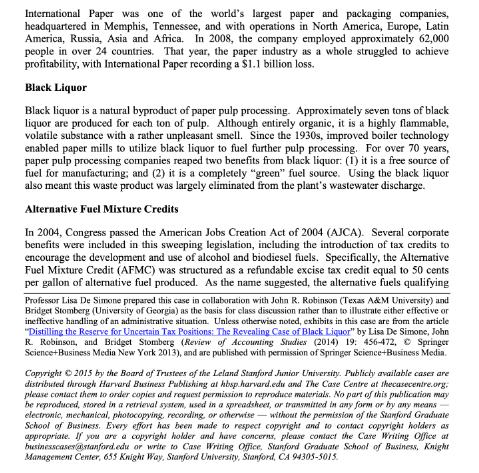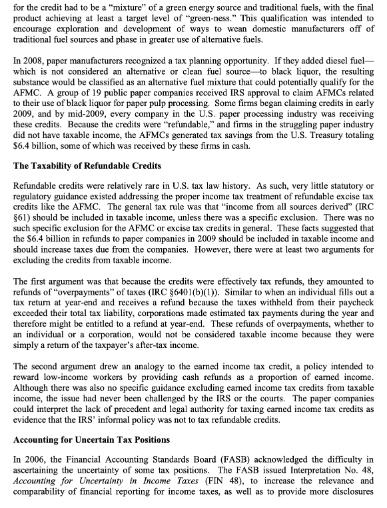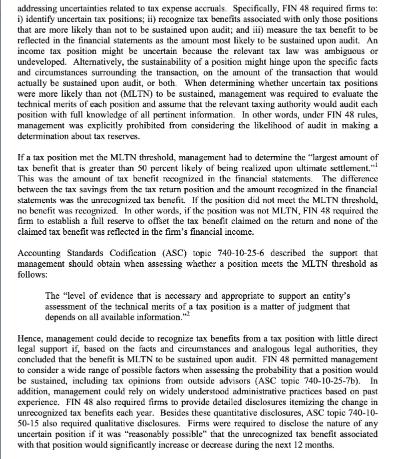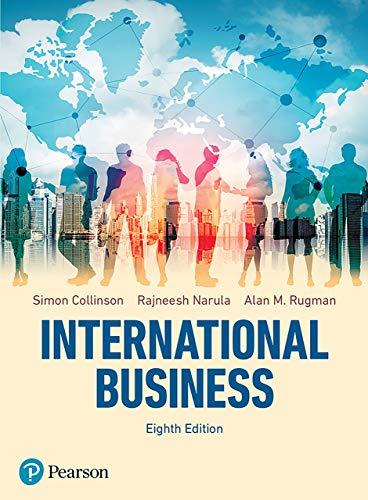Answered step by step
Verified Expert Solution
Question
1 Approved Answer
International Paper was one of the world's largest paper and packaging companies, headquartered in Memphis, Tennessee, and with operations in North America, Europe, Latin



International Paper was one of the world's largest paper and packaging companies, headquartered in Memphis, Tennessee, and with operations in North America, Europe, Latin America, Russia, Asia and Africa. In 2008, the company employed approximately 62,000 people in over 24 countries. That year, the paper industry as a whole struggled to achieve profitability, with International Paper recording a $1.1 billion loss. Black Liquor Black liquor is a natural byproduct of paper pulp processing. Approximately seven tons of black liquor are produced for each ton of pulp. Although entirely organic, it is a highly flammable, volatile substance with a rather unpleasant smell. Since the 1930s, improved boiler technology enabled paper mills to utilize black liquor to fuel further pulp processing. For over 70 years, paper pulp processing companies reaped two benefits from black liquor: (1) it is a free source of fuel for manufacturing; and (2) it is a completely "green" fuel source. Using the black liquor also meant this waste product was largely eliminated from the plant's wastewater discharge. Alternative Fuel Mixture Credits In 2004, Congress passed the American Jobs Creation Act of 2004 (AJCA). Several corporate benefits were included in this sweeping legislation, including the introduction of tax credits to encourage the development and use of alcohol and biodiesel fuels. Specifically, the Alternative Fuel Mixture Credit (AFMC) was structured as a refundable excise tax credit equal to 50 cents per gallon of alternative fuel produced. As the name suggested, the alternative fuels qualifying Professor Lisa De Simone prepared this case in collaboration with John R. Robinson (Texas A&M University) and Bridget Stomberg (University of Georgia) as the basis for class discussion rather than to illustrate either effective or ineffective handling of an administrative situation. Unless otherwise noted, exhibits in this case are from the article "Distilling the Reserve for Uncertain Tax Positions: The Revealing Case of Black Liquor" by Lisa De Simone, John R. Robinson, and Bridget Stomberg (Review of Accounting Studies (2014) 19: 456-472, Springer Science+Business Media New York 2013), and are published with permission of Springer Science+Business Media. Copyright 2015 by the Board of Trustees of the Leland Stanford Junior University. Publicly available cases are distributed through Harvard Business Publishing at hbsp.harvard.edu and The Case Centre at thecasecentre.org. please contact them to order copies and request permission to reproduce materials. No part of this publication may be reproduced, stored in a retrieval system, used in a spreadsheet, or transmitted in any form or by any means electronic, mechanical, photocopying, recording, or otherwise without the permission of the Stanford Graduate School of Business. Every effort has been made to respect copyright and to contact copyright holders as appropriate. If you are a copyright holder and have concerns, please contact the Case Writing Office at businesscases@stanford.edu or write to Case Writing Office, Stanford Graduate School of Business, Knight Management Center, 655 Knight Way, Stanford University, Stanford, CA 94305-5015. for the credit had to be a "mixture" of a green energy source and traditional fuels, with the final product achieving at least a target level of "green-ness." This qualification was intended to encourage exploration and development of ways to wean domestic manufacturers off of traditional fuel sources and phase in greater use of alternative fuels. In 2008, paper manufacturers recognized a tax planning opportunity. If they added diesel fuel- which is not considered an alternative or clean fuel source to black liquor, the resulting substance would be classified as an alternative fuel mixture that could potentially qualify for the AFMC. A group of 19 public paper companies received IRS approval to claim AFMCs related to their use of black liquor for paper pulp processing Some firms began claiming credits in early 2009, and by mid-2009, every company in the U.S. paper processing industry was receiving these credits. Because the credits were "refundable," and firms in the struggling paper industry did not have taxable income, the AFMCs generated tax savings from the U.S. Treasury totaling $6.4 billion, some of which was received by these firms in cash. The Taxability of Refundable Credits Refundable credits were relatively rare in U.S. tax law history. As such, very little statutory or regulatory guidance existed addressing the proper income tax treatment of refundable excise tax credits like the AFMC. The general tax rule was that "income from all sources derived" (IRC 61) should be included in taxable income, unless there was a specific exclusion. There was no such specific exclusion for the AFMC or excise tax credits in general. These facts suggested that the $6.4 billion in refunds to paper companies in 2009 should be included in taxable income and should increase taxes due from the companies. However, there were at least two arguments for excluding the credits from taxable income. The first argument was that because the credits were effectively tax refunds, they amounted to refunds of "overpayments" of taxes (IRC 6401(b)(1)). Similar to when an individual fills out a tax return at year-end and receives a refund because the taxes withheld from their paycheck exceeded their total tax liability, corporations made estimated tax payments during the year and therefore might be entitled to a refund at year-end. These refunds of overpayments, whether to an individual or a corporation, would not be considered taxable income because they were simply a return of the taxpayer's after-tax income. The second argument drew an analogy to the earned income tax credit, a policy intended to reward low-income workers by providing cash refunds as a proportion of eamed income. Although there was also no specific guidance excluding earned income tax credits from taxable income, the issue had never been challenged by the IRS or the courts. The paper companies. could interpret the lack of precedent and legal authority for taxing earned income tax credits as evidence that the IRS' informal policy was not to tax refundable credits. Accounting for Uncertain Tax Positions In 2006, the Financial Accounting Standards Board (FASB) acknowledged the difficulty in ascertaining the uncertainty of some tax positions. The FASB issued Interpretation No. 48, Accounting for Uncertainty in Income Taxes (FIN 48), to increase the relevance and comparability of financial reporting for income taxes, as well as to provide more disclosures addressing uncertainties related to tax expense accruals. Specifically, FIN 48 required firms to: i) identify uncertain tax positions; ii) recognize tax benefits associated with only those positions that are more likely than not to be sustained upon audit; and iii) measure the tax benefit to be reflected in the financial statements as the amount most likely to be sustained upon audit. Ant income tax position might be uncertain because the relevant tax law was ambiguous or undeveloped. Alternatively, the sustainability of a position might hinge upon the specific facts and circumstances surrounding the transaction, on the amount of the transaction that would actually be sustained upon audit, or both. When determining whether uncertain tax positions were more likely than not (MLTN) to be sustained, management was required to evaluate the technical merits of each position and assume that the relevant taxing authority would audit each position with full knowledge of all pertinent information. In other words, under FIN 48 rules, management was explicitly prohibited from considering the likelihood of audit in making a determination about tax reserves. If a tax position met the MLTN threshold, management had to determine the "largest amount of tax benefit that is greater than 50 percent likely of being realized upon ultimate settlement." This was the amount of tax benefit recognized in the financial statements. The difference between the tax savings from the tax return position and the amount recognized in the financial statements was the unrecognized tax benefit. If the position did not meet the MLTN threshold, no benefit was recognized. In other words, if the position was not MLTN, FIN 48 required the firm to establish a full reserve to offset the tax benefit claimed on the return and none of the claimed tax benefit was reflected in the firm's financial income. Accounting Standards Codification (ASC) topic 740-10-25-6 described the support that management should obtain when assessing whether a position meets the MLTN threshold as follows: The "level of evidence that is necessary and appropriate to support an entity's assessment of the technical merits of a tax position is a matter of judgment that depends on all available information." Hence, management could decide to recognize tax benefits from a tax position with little direct legal support if, based on the facts and circumstances and analogous legal authorities, they concluded that the benefit is MLTN to be sustained upon audit. FIN 48 permitted management to consider a wide range of possible factors when assessing the probability that a position would be sustained, including tax opinions from outside advisors (ASC topic 740-10-25-7b). In addition, management could rely on widely understood administrative practices based on past experience. FIN 48 also required firms to provide detailed disclosures itemizing the change in unrecognized tax benefits each year. Besides these quantitative disclosures, ASC topic 740-10- 50-15 also required qualitative disclosures. Firms were required to disclose the nature of any uncertain position if it was "reasonably possible" that the unrecognized tax benefit associated with that position would significantly increase or decrease during the next 12 months.
Step by Step Solution
★★★★★
3.54 Rating (147 Votes )
There are 3 Steps involved in it
Step: 1
The case youve provided discusses the tax issues related to the use of black liquor by paper manufac...
Get Instant Access to Expert-Tailored Solutions
See step-by-step solutions with expert insights and AI powered tools for academic success
Step: 2

Step: 3

Ace Your Homework with AI
Get the answers you need in no time with our AI-driven, step-by-step assistance
Get Started


